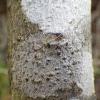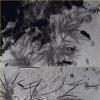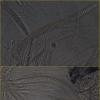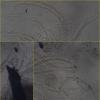
21-12-2025 09:32
Hello.A tiny ascomycete found embedded in wood in

21-12-2025 21:32
Pol DebaenstHello, Garden, Burgweg 19, Veurne, BelgiumOn 10/1

22-12-2025 23:38
Patrice TANCHAUDBonsoir, récolte sur un mur en pierre, apothéci

22-12-2025 00:47
Patrice TANCHAUDBonsoir, récolte à proximité du milieu dunaire

21-12-2025 21:40
Isabelle CharissouBonjour, j'aimerais connaitre les références de

20-12-2025 23:08
Patrice TANCHAUDBonsoir, récolte sur sol sablonneux dans l'arri�
Asci with 8 spores each; The spores are 1-septate when young and then develop other septa, up to 8-septate.
Asci: up to 215 x 12 um;
Spores:
(26.7) 29.2 - 33.7 (34.5) x (6.2) 6.5 - 7.9 (8.1) µm
Q = (3.9) 4 - 4.76 (4.8) ; N = 20
Me = 31.2 x 7.2 µm ; Qe = 4.4,
I will appreciate any hint for the classification.
Thanks in advance,
zaca

In fact, I thought this was a lichen, but I found no trace of an alga.
The last two sets of photos (except for the one on the left hand of the last) were taken after join a drop of melzer to the slide. This permits to see clearly the septation of the spores, which was not possible without it.
Thanks again,
zaca

It is well possible that the asci are inamyloid. Anyhow I would try Lugol for a possible hemiamyloid reaction.
The spores ar very characteristic, I think a lichenologist knows them.
I will follow your suggestions and try a new preparation, whenever possible. If I'll find anything different, it will be reported here.
Thanks,
zaca
Hi Zaca,
Like Zotto, I think it could be a lichen, with leprose thallus.
You can test chemical reactions on the thallus : K, P, C, KC.
How are ascomatas ? Perithecias ? Apothecias ?
Alain
The ascomata are perithecia. I made the spot tests and all chemical reactions were negative. Moreover, did new microscopic observation and found that there seems to be a brown or golden-green alga (perhaps of the genus Trentepohlia). I checked the reference mentioned below and, taking into account the microscopic data, found two genera of pyrenocarpous to which my specimen can belong: Porina or Strigula. I found, in particular, a species _Strigula stigmatella_ with similar features.
Many Thanks to Zotto and to Alain, for their comments that lead me to the possible solution,
zaca
Ref:
Alan Orange, British and Other Pyrenocarpous Lichens, 2013.
(available at: https://www.museumwales.ac.uk/media/13849/Orange,-A.-(2013)-British-and-other-pyrenocarpous-lichens.pdf)



